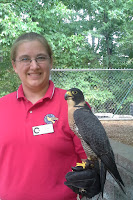The creation of mythical
creatures in history is often the result of a primitive perception of an event
or behavior observed in relation to an existing bird, mammal, or reptile. Today, we can explain these
events or behaviors through research and study.
Even in the modern day,
pictures or mounted versions of unusual animals crop up in our culture and
generally a person could question, for a period of time, whether that creature
was real or not. The term used to
describe many of these modern-day mythical creatures is a ‘hoax’. These hoax animals are often the result
of a practical joke and presented in such a convincing manner that many
individuals may believe it was real initially.
A classic example would be
the Jackalope.
A mounted
Jackalope (photo: wikipedia)
As the story
goes…Jackalopes have the body of a rabbit and the antlers of an antelope. They are a species thought to be
extinct, but rare sights of pocket populations have been found in Western
America. A contributing factor
theorized for their small numbers is that they only mate when flashes of
lightning occur. They are credited
with the ability to mimic human sounds and often utilize this ability to avoid
capture. Jackalopes are also
highly aggressive and will use their antlers to fight.
The Jackalope was first
introduced in the 1930s by two brothers, Douglas and Ralph Herrick, when they
combined the body of a recently killed rabbit with a pair of deer antlers in
their taxidermy shop. The stuffed
‘Jackalope’ became a very popular souvenir of visitors in their hometown of
Douglas, Wyoming.
Among the birding
community, we have the ‘almost seen’ or ‘almost captured’ Bare-fronted Hoodwink
bird species. The existence of
this species has only been inferred by ornithologist, M. F. Meiklejohn, who
studied these very shy and ‘only partially seen’ birds. He stated that this species can be
identified by its blurred appearance and extremely rapid flight away from the
observer. He had an interesting
statistic in that amateur bird watchers were more skilled in pinpointing this
elusive species than more experienced bird watchers.
Another convincing animal
hoax was the Hot-headed Naked Ice Borer presented in a 1995 April DISCOVER
magazine article.
A doctored photo
of a Naked Mole Rat claimed to be the Hot-headed Naked Ice Borer (photo: wikipedia)
A wildlife biologist, named Aprile Pazzo, was studying a
penguin population along the coast of the Ross Sea when the penguins panicked
and one rapidly sank into the ice.
When she pulled the trapped penguin out, several hairless and mole like
creatures were attached to the penguin’s lower body by their sharp incisors.
She would collect several of these strange creatures for study. Adults were half a foot long and
weighed only ounces. With their high
metabolic rate (body temperature at 110 degrees), they could radiate their
incredible heat through a bony plate located on their forehead. Using the concentration of heat, they
would bore their way through the ice and melt the ice underneath their favorite
prey: penguins.
The article was printed as
an April Fool’s joke in the DISCOVER magazine with the researcher ‘Aprile
Passo’ meaning ‘April Fool’ in Italian.
The article received many response letters from institutes joking and
asking where they could obtain a few specimens for display for researchers
expanding the biology, habit, and physiology of hot-headed naked ice
borers. A recent printing of the
1995 article and humorous response letters can be found here.
When you attend one of the World Bird Sanctuary educational shows you can be certain that the information you receive, although always entertaining, will not be a myth, legend or April Fool's joke. The facts surrounding the animals featured at WBS shows are so amazing that no fabricated myths or legends are needed.
Submitted by Jessica Bunke, Naturalist/Trainer






No comments:
Post a Comment